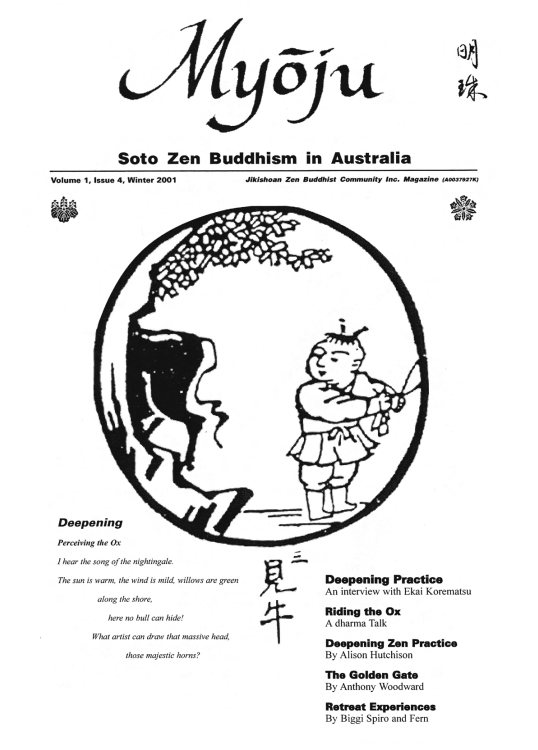Editorial
Welcome to the winter edition of Myoju, the magazine of Jikishoan Zen Buddhist Community in Melbourne, Australia. Following on from the last edition which focused upon ‘beginning’, the theme of this the fourth edition is ‘deepening’.
This edition considers what deepening practice is, and what it actually involves. Reflecting upon Ekai’s talks and our interview together, the common thread that emerges is that deepening practice involves returning: returning to silence, returning to the self. So what happens when you actually engage in this process?
Anthony’s article on p.4 describes how, within one year, he went from reading Suzuki’s ‘Crooked Cucumber’ in Ballarat, to practising at the centre Suzuki set up in San Francisco.
Biggi and Fern’s poems on p.6 express their experience of the Easter Retreat. They are an indication of what happens when you engage in 7 days of intense practice.
In Alison’s article on p.14 she reflects upon her last few years of practice, which she describes as ‘like peeling layers off an onion’.
I remember when I first began sitting that a very strong image flashed into my mind. It was an image of ‘me’ or my ‘personality’. The image was of an impossibly tangled ball of string. My feeling at the time was that it would be ridiculous to attempt to untangle it bit by bit. Best to leave it as it is and accept it. Of late the process of returning to the self for me has meant the arising and remembering of some very powerful old memories, experiences and feelings. What will come of this? I don’t know. Is there something inside the ball of string? I’m not sure.
In the interview on p.10 Ekai likens this process to driving a car. He advises that we not become caught up in the scenery as we take this journey, that we let these thoughts and emotions come and go. Dogen writes that:
Driving ourselves to practice and experience the myriad dharmas is delusion. When the myriad dharmas actively practice and experience ourselves, that is the state of realisation.
I guess I’ll just have to continue returning, and find out for myself if there is a ‘returner’, or just an ongoing process of returning and arising.
Thank you to all who have contributed ideas, articles and artwork to this edition of Myoju. Without the generosity of spirit of the members of the Jikishoan community this publication could not exist. Thank you to Leesa for her long distance proofreading and suggestions, to Anthony, for many of the illustrations used in this issue, and to Karen for her creative design and skillful layout. And as always, thank you to Ekai for sharing this practice.
Gary Youston

